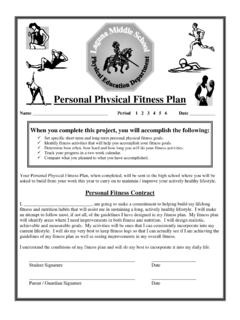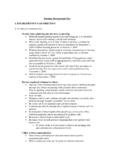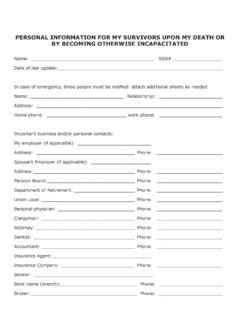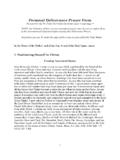Transcription of Personal Dock Building - TechniDock Inc.
1 Personal dock Building Waterfront Development Notes for Residential Docks Personal dock Building _____ _____ 1 Contents Introduction Page 2 Planning Notes & Descriptions Page 4 Local EWaterfront Questions Page 15 dock Building Glossary of Terms Page 17 Tables Planning Checklist Page 3 Flotation Comparison Page 7 Deck Material Comparison Page 10 Maintenance Checklist Page 12 EWaterfront Site Inventory Page 23 EWaterfront Product Selection Page 24 Copyright 2006 by TIGOR All Rights Reserved ISBN 978-0-9771155-1-8 Reprinted by Permission Donations and proceeds from the sale of this book benefit local Marina Day, Marina Day Kids and Clean Marina programs.
2 For further information contact: Personal dock Building _____ _____ 2 Introduction Construction methods on and along the waterfront vary from state to state and region to region. Regulations to build a Personal dock span the extremes too much, as to cause non-conformance and frustration too little, causing environmental and life-safety problems. Some areas have very strict licensing and permit procedures, some areas have no regulation on floating structures at all. As an introduction to your Personal dock project, consider the following: What it floats on --- encased flotation which can handle wave action, garbage, sunlight and varying weight loads; while still keeping sufficient buoyancy and stability.
3 Stationary docks are usually anchored to pilings or pier structures (and don t require floats). What's the frame made of --- steel, aluminum, wood, plastic, composite all have their benefits with reference to twisting, strength, and exposure to outside elements. What you walk on --- literally hundreds of composite deck materials are available. Make sure they span 24", have skid resistance, don't lose strength in the sun, and have a warranty that means something. A common sense note -- if a product has all the draw-backs of wood (fuel for fire, splinters, stains, etc.) is it worth choosing an alternative material which will cost more? Each dock component may have a different structural requirement and maybe better or worse for any given site.
4 Good dock Building blends the positive features of construction materials with environmental awareness and easy installation. This booklet is a dock Building guide for Personal property owners promoting clean, safe and sustainable waterfront environments. Included are notes contributed by marine contractors and design professionals to help educate homeowners about construction on the waterfront. This is not a how-to manual, nor is it a substitute for advice and direction from qualified experts about a specific site or local waterway. Personal dock Building _____ _____ 3 dock Planning Checklist Use the following table to investigate your dock site. Record notes and questions for your contractor on separate sheets.
5 ( ) Item Description Result 1 Soil / Site Analysis (waterbed) 2 Utility lines located 3 Water depth 4 Changes in water elevation 5 dock design / type 6 Choice of float material 7 Choice of frame material 7a Extra framing note 7b Extra framing note 7c Extra framing note 8 Choice of deck material 9 Anchoring type 10 Hardware type 11 Accessories - bumper 11a Accessories - boatlift 11b Accessories - other 11c Accessories - other 12 Construction 13 Maintenance review 14 Clean waterfront review T Shaped Floating dock Using Ramp U Shaped Floating
6 dock with Cover Personal dock Building _____ _____ 4 dock Planning Notes & Descriptions 1. Soil / Site Analysis (waterbed) If new or special anchoring of your dock is required, you may need to know the type of soil in the waterbed and onshore. Most local contractors have an understanding of the limits of your soil for piling (and other anchoring). Local Building departments and regulatory agencies can also explain your water bottom characteristics. 2. *Utility Lines Located Insure that all underground utilities are located. Overhead utilities should be sited, if any will interfere with erection equipment or moving materials. Most utility districts have free services to locate their lines.
7 Reference the need, location and protection of all lines on, in, or near the water. 3. *Water Depth Insure the water is deep enough to handle the draft of your boat, then add two feet. This is your minimum water depth. If the body of water has depth charts, look for Mean Low Water (MLW). 4. *Change in Water Depth If the water depth changes, insure the dock is in a location which allows your minimum water depth. If the dock will be aground at any time, additional bracing should be added to protect fastener connections and flotation. 5. * dock Design / Type General site characteristics and water depth will dictate your dock layout. How stable your dock feels depends on the width of the dock sections, dock structure, and the layout.
8 Long straight sections may need to be wider, have more anchoring, or more framing components. When possible design sections with an end section for stability ( L , U , H , T Shapes). Look for added strength features such as: a) Finger sections designed to go through the main walk b) Additional framing support Personal dock Building _____ _____ 5 6. Choice of Float Material Most dock flotation is made of some form of polystyrene (Styrofoam). Without protection (coatings or encasement) polystyrene will break-apart over time. Wave action, garbage, sunlight, insects and rodents --- all contribute to float damage. Lakes and waterways governed by the Army Corps of Engineers (and many other regulated waterways) will not allow polystyrene which is not protected (encased).
9 Encased flotation with galvanized steel frames Encased flotation is the preferred method and can be compared using several factors: a) Resistance of the encasing to Ultra-violet (UV) light. b) Thickness of the encasing material. Thicker materials have more resistance to rodents and puncture. c) Weight /Buoyancy of the float unit. Most manufacturers have buoyancy tables to help you calculate how many floats . A number of tests are available to compare the quality of encasement and floatation material. The following should be researched further to gain a full understanding of this dock component. a) Wall Thickness Test acceptable wall thickness (minimum is ), nominal.
10 B) Hunt 7 Day Absorption Test measures water adsorption limits (minimum is 3 lbs/cu. Ft.) c) ASTM Falling Dart Puncture Test measures impact resistance under extreme conditions Personal dock Building _____ _____ 6 In the best of all worlds choose floats which are light and strong with high buoyancy. To calculate an average load for dock construction use this: Example --- Take the dead load , (the weight of dock materials) Example: 6' x 20' floating dock section weighs approximately 1,000 lbs or pounds per square foot. Add permanent weight on dock ( dock box, deck furniture) Add the weight of people, Example: two people 170 pounds each in a twenty-five square foot area or pounds per square foot.






